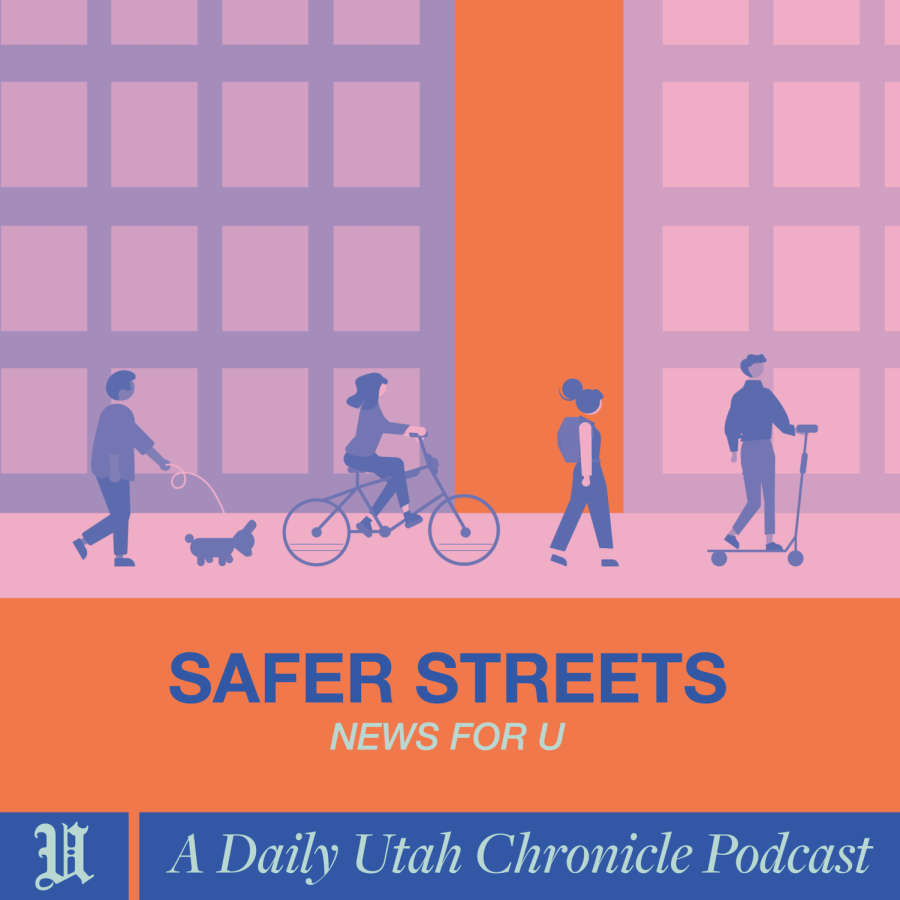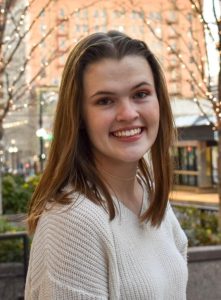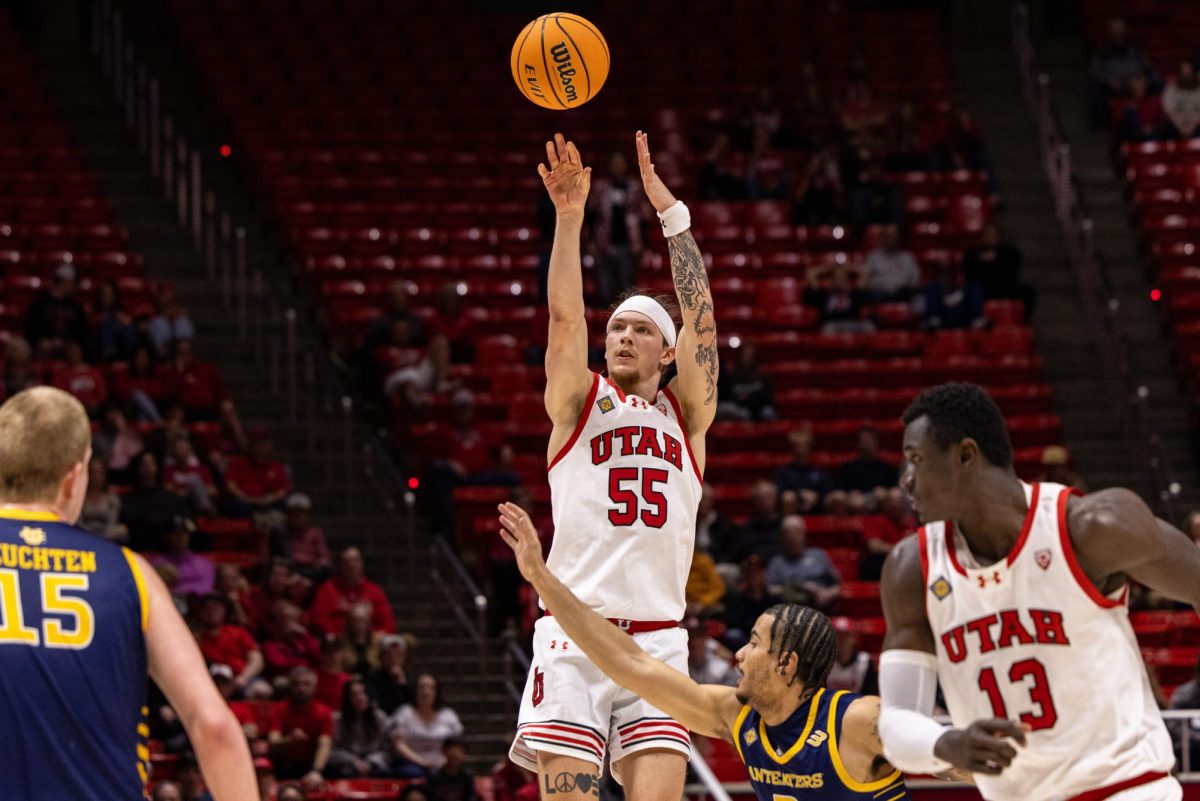News for U — Episode 7: Safer Streets in SLC
(Graphic by Claire Peterson | The Daily Utah Chronicle)
April 10, 2023
Emma Ratkovic 0:04
Hello, and welcome back to News For You, the Daily Utah Chronicle news podcast. I’m Emma and on today’s episode of the podcast, we are going to talk about the plan to make Salt Lake streets safer for pedestrians and cyclists. Assistant news editor Andrew Christiansen has joined us today to discuss how an advocacy group has led the way to make Salt Lake streets safer for pedestrians and cyclists. Andrew’s story is in the newest print edition of the Chronicle’s Changemakers issue, which focuses on Solutions Journalism. Hi, Andrew, thank you for joining us on the podcast today.
Andrew Christiansen 0:40
Thanks for having me, Emma.
Emma Ratkovic 0:41
Andrew, can you tell us a little bit about yourself and what you do at the Chronicle?
Andrew Christiansen 0:45
I’ve been the assistant news editor for almost a year now and in that position, I’m just one of the leaders of the news desk, which has around eight people right now. But you know, we kind of frequently fluctuate with writers leaving and new writers coming along, but basically, just help edit stories and you know, write stories as well, when I have the time.
Emma Ratkovic 1:03
According to your story, Sweet Streets is a group that educates and advocates for safer roads and public spaces. Can you explain the background of this group and why it was created?
Andrew Christiansen 1:14
Taylor Anderson, co-founder of Sweet Streets, is kind of the main person I talked to for this story. And he told me that he and his friends kind of heard this similar sentiment in recent years from people in the community, which is, essentially, that whether they were walking around, biking, taking transit around the city, they felt unsafe, and like they were at risk of getting in a serious accident. So, and, this is kind of data that Safe Streets has collected by themselves, but in 2022 alone, there were 21 fatalities, and many injuries on Salt Lake City roads. And of course, a lot of that includes pedestrians and bikers. So with all these things in mind, Taylor and his friends decided in 2019, that they needed to take some sort of bigger action to make the streets safer. And that’s why they decided to kind of start up Sweet Streets.
Emma Ratkovic 1:58
What is the “20 is Plenty” campaign?
Andrew Christiansen 2:00
Sweet Streets has several campaigns they advocate for, but this was kind of the first one that they chose to focus on, and probably the most successful one so far. And it basically called on the Salt Lake City Council to adopt a default 20 mph speed limit on most city streets. It’s actually pretty interesting that “20 is Plenty” campaign started in Bristol, England, and there’s kind of versions of the campaign across the country. But for Salt Lake City’s version, Sweet Streets just, kind of, tried to get the word out by placing “20 is Plenty” signs around the city that you guys maybe have seen, started an online petition to show the city council that the community kind of wanted to make this change. And then this kind of all led up to last May when the City Council voted to lower the speed limit from 25 miles per hour to 20 on about 420 miles or 70% of the streets in the city.
Emma Ratkovic 2:51
In your story, you describe how research shows that the design of the streets has a big impact on the speed people feel comfortable driving. Can you further explain how street design plays a role in street safety?
Andrew Christiansen 3:03
So, this is a really interesting part of the story that I honestly just hadn’t really considered that much before. And Taylor told me that, you know, as you’re kind of talking about the research shows the design of the street plays a bigger role than speed limits and how fast people feel comfortable driving. So this can include if there are trees on the side of the street, what lane width the street is, whether there are speed bumps, speed tables or raised crosswalks. And in Salt Lake in particular, you know, we have really wide roads and fun little, I guess historical fact is that they were originally designed to be large enough to turn around a team of oxen, but Taylor told me that he kind of sees this as an opportunity to improve the design of city streets because there’s just so much room to work with.
Emma Ratkovic 3:46
What is the Sweet Streets “Neighborhood Byway 2025” campaign?
Andrew Christiansen 3:50
So this basically calls on Salt Lake to find and build a network of neighborhood byways by 2025. And these byways are basically low traffic, low speed streets that often include things to promote low traffic speeds, including, you know, speed tables and speed bumps like I was just talking about. And I think a good way of explaining it is what Taylor told me, which is a road that you would feel comfortable biking with a kid or a grandparent or somebody that’s not comfortable riding among high-speed traffic. So in the 2015 Salt Lake Bike Ped Master Plan, which is, it’s really fascinating to kind of look through this plan that they set up almost 10 years ago, and but one of the things they recommended is building this kind of network of neighborhood byways that totaled 68 miles. Snd the city said its goal is to complete 10 byways by 2025 but so far they’ve only built one and you know, time’s running out. So, you know, this Sweet Streets campaign is basically just trying to hold the city accountable to these plans that the city set out and I will say the city has a lot of neighborhood byways like planned for this year and next year, you can kind of check on slc.gov/transportation/neighborhood-byways, they have kind of updates on where those neighborhood byways, like the plans for those — it’s coming along, but they’re cutting it pretty close with it almost being 2025.
Emma Ratkovic 5:07
What is the “200 South Bus Corridor” campaign?
Andrew Christiansen 5:10
This would create Salt Lake’s first bus-only lane, running from the University of Utah to 600 West every 15 minutes.There would also be protected lanes for people on bicycles, skateboards and scooters. And it would basically just be a much more efficient bus route that goes West and as far East as the U’s campus and just kind of improving public transportation while also providing a road that spans the city, that has lanes for bikes and skateboards and such.
Emma Ratkovic 5:37
In your article, you mentioned that Mayor Mendenhall announced that Salt Lake will be the first city in Utah to join the Vision Zero network. What is the Vision Zero network and what does the mayor hope to achieve by joining?
Andrew Christiansen 5:49
The Vision Zero Network is basically this national strategy to eliminate all traffic fatalities and severe injuries on city streets. And what goes into the exact strategy kind of depends on the city, but it’s a lot of what we’ve kind of already discussed so far, and plenty of other things of just how to make streets safer. And, just from, based on the people that I’ve talked to for this story is, this is a pretty exciting step because Salt Lake will be the first city in the state to join the networkand I think the mayor just hopes to send a message to the community that she’s truly committed to making Salt Lake streets safer.
Emma Ratkovic 6:23
What steps need to be taken until Salt Lake officially becomes a Vision Zero City?
Andrew Christiansen 6:28
So there’s a few steps and the first one was just getting that declaration from the mayor, which happened earlier this year. And then another step is having a guiding Vision Zero action plan. So this kind of lays out specific goals on how to make the city safer. And then the transportation division is working right now to do this with the Wasatch Front Regional Council. And then there’s also a Vision Zero task force, which they’ve kind of created, which they help identify areas of the city where intervention might be necessary to prevent future crashes and they also hold the transportation division accountable for actually implementing this action plan that they’re still in the process of making. And I guess to add on, I think the easiest way to explain why Salt Lake joining the Vision Zero Network is important is it provides a sort of unified vision and mandate to the transportation division to make streets safer across the city. And it also provides a template for other cities in the state to follow if they want to become a Vision Zero City as well.
Emma Ratkovic 7:26
When does Salt Lake plan to officially become a Vision Zero City?
Andrew Christiansen 7:30
I’m not for sure exactly, Jon Larsen, Salt Lake’s transportation division director, told me that they have a pretty good shot of being able to check all these boxes by the end of this year, but it might not be until, like, early 2024.
Emma Ratkovic 7:44
According to your story, there’s a long road ahead to ensure safety for pedestrians and cyclists. What decisions can people make today to create safer Salt Lake streets in the future?
Andrew Christiansen 7:54
I think one of the biggest things that I got from my conversation with Taylor is that, despite the success with street safety, Salt Lake still has a ways to go to, you know, to actually make their streets safer for pedestrians and cyclists. And I think the first thing that people can do is kind of just inform themselves about what it even means to be a safe city for pedestrians and cyclists. And I’ll be honest, like I didn’t know a whole lot about this before I wrote this story, so it’s been a good learning experience for me. And I think just kind of learning about the importance of you know, things like reducing speed limits, neighborhood roads, and more importantly, the kind of overall street design and all the options that we can implement to encourage vehicles to slow down with speed bumps, speed tables, smaller widths of lanes and raised sidewalks, and stuff like that. And I guess to add on what makes probably even more of an impact, I think is just using public transportation or any alternative to driving, like riding a bike when you can, it’s kind of an obvious thing to say, but fewer cars on the road create safer streets.
Emma Ratkovic 8:54
Do you have any final thoughts or comments?
Andrew Christiansen 8:56
Yeah, I mean, I guess building off my, like, last answer. If you know, if you want to help create safer Salt Lake streets, I think it’s important to support advocacy groups like Sweet Streets and really educate yourself on their campaign, sign petitions, go to city council meetings about important decisions relating to street safety. And part of this story was to sort of chronicle and highlight the successes Sweet Streets has had so far, it was also about acknowledging that the “20 is Plenty” campaign is only step one in making Salt Lake streets safer. But I think to end on a kind of more positive note, people like Taylor have told me that they feel like the city is kind of in the midst of a unique time where people are more aware than ever that the city has been designed in a very car-centric way for a long time, and has a lot of potential to be safer and accessible to everyone. So I think there’s a lot of desire from the community to make their voices heard and make actual change that will make them feel safer as pedestrians and bikers in Salt Lake.
Emma Ratkovic 9:57
Thank you so much, Andrew, for joining us today on the podcast.
Andrew Christiansen 10:00
Thanks for having me!
Emma Ratkovic 10:01
Thank you for tuning in to this week’s episode of News for U! Make sure to tune into a new episode next Monday.
Executive Producer: Theadora Soter — [email protected] | @sotertheadora
Producer: Graham Jones — [email protected] | @grahamcool8
Host: Emma Ratkovic — [email protected] | @eratkovic_news
Guest: Andrew Christiansen — [email protected] | @andrewwriter01












